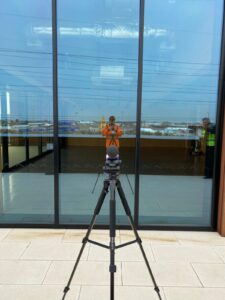This website uses cookies so that we can provide you with the best user experience possible. Cookie information is stored in your browser and performs functions such as recognising you when you return to our website and helping our team to understand which sections of the website you find most interesting and useful.
NAME: Sam Logan
DATE JOINED TEMPLE: November 2019
My role as an acoustic consultant provides me with a working week full of variation. Days vary, one day I could be on site collecting data, and on another I’m in the office running calculations or creating models. When the week is a little quieter, I can be found working from home writing reports with a big mug of coffee. The main purpose of my role is to undertake acoustic assessments and to write these reports for clients who have an issue we can help resolve.
When the weather is calm and the sun is shining, there’s no better place to be than outside. So, here’s a day in the life of an acoustics consultant on site.
Morning
I have never been a morning person, so I always do my preparation for site work before I go to bed the previous evening. Usually, the kit is spread across my living room floor, and I meticulously check off everything I need. Nothing worse than arriving at the site and realising you have one more sound level meter than memory cards…
Once it’s all packed into the Zipcar that’s conveniently outside my door, it’s time to drive. Usually, our surveys are within Central London but within the last year, I’ve been out to other destinations such as Ramsgate, High Wycombe, and Shepperton.
Once arriving at the site first thing I do is find somewhere to park and someone to let you in. After a quick walk around the site to note any noise sources that may have been missed from the survey plan, the first step is to install the unattended monitors that will record noise levels continuously over the week. Usually, this involves lugging a heavy box and pole up to the roof of a building but outside of the city, it’s often across a muddy field.
Setting up the meter is a “check twice” kind of job, nobody wants to be the person who comes back to collect the data in a week and sees the monitor hasn’t been logging. It’s key to take some good notes as I set these up as to what I can hear. Anything that contributes to the sound profile is important as the proposed development may change the noise sources in the area.
Once I have set up all the unattended monitors, it’s time to take some other measurements around the site to further inform the acoustic strategy. If the site is by a busy road, it’s important to quantify its contribution to the noise climate. This is done by undertaking measurements at the side of the road over a few hours. It’s usually around that time when a member of the public comes to ask you what you are doing, the nice ones ask quietly but some people see a microphone and just want to shout.
After the first set of measurements, I break for a late lunch and probably another coffee.
Afternoon
Finally, any more surveys that need undertaking are to be done. In addition to roads, the noise contribution from close by train lines must be evaluated. This often requires two surveys: noise and vibration (my favourite) and your best Francis Bourgeois impression as you manically try to note the train type, number of carriages, speed, and direction.
After I have got all the data, I need it back to sign out and start the drive to the kit room to drop off all the gear. Once back home I like to save the data ASAP, as all those memory cards start to look the same if you don’t. Finally, I upload all my pictures and notes from the day and update my survey plan for the collection next week if a change is required.
About a week later it’s time to collect the equipment. Repeating all the above steps in reverse order allows for more measurements while the unattended meters keep logging. Hopefully, the weather has been calm and dry throughout the week and all your data is valid.
Depending on traffic and location site days can be your longest or shortest of the week, but it’s the variation that keeps it exciting.

